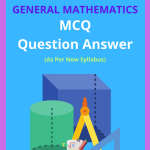SEBA Class 10 Mathematics MCQ Chapter 3 Pair of Linear Equations in Two Variables Question Answer in English Medium, Class 10 General Maths Multiple Choice Question Answer in English to each chapter is provided in the list so that you can easily browse throughout different chapters SEBA Class 10 Mathematics MCQ Chapter 3 Pair of Linear Equations in Two Variables Notes and select need one.
SEBA Class 10 Mathematics MCQ Chapter 3 Pair of Linear Equations in Two Variables
Also, you can read the SCERT book online in these sections Solutions by Expert Teachers as per SCERT (CBSE) Book guidelines. These solutions are part of SCERT All Subject Solutions. Here we have given Assam SEBA Class 10 Mathematics MCQ Chapter 3 Pair of Linear Equations in Two Variables Solutions for All Subject, You can practice these here.
Pair of Linear Equations in Two Variables
Chapter – 3
| MCQ |
1. Graphically, the pair of equations 7x – y = 5; 21x – 3y = 10 represents two lines which are:
(a) intersecting at one point
(b) parallel
(c) intersecting at two points
(d) coincident
Ans: (b) parallel
2. Graphically, the pair of equations 6x-3y+10=0,2x-y+9=0 represents two lines which is-
(a) will intersect at exactly one point
(b) will intersect at exactly two points
(c) coincident
(d) will be parallel
Ans: (d) will be parallel
3. If a pair of linear equations is consistent, then the lines will be:
(a) parallel
(b) always coincident
(c) intersecting or coincident
(d) always intersecting
Ans: (c) intersecting or coincident
4. The pair of equations x = 0 and y = – 7 has:
(a) one solution
(b) two solutions
(c) infinitely many solutions
(d) no solution
Ans: (a) one solution
5. The pair of equations x = a and y = b graphically represents lines which are:
(a) parallel
(b) intersect at (b, a)
(c) coincident
(d) intersect at (a, b)
Ans: (d) intersect at (a, b)
6. If the lines given by 3x + 2ky = 2 and 2x + 5y + 1 = 0 are parallel, then the value of k is:
(a) – 5/4
(b) 2/5
(c) 15/4
(d) 3/2
Ans: (a) – 5/4
6. How many solutions, a linear equation in two variables has?
(a) one solution
(b) two solutions
(c) no solution
(d) infinite number of solutions
Ans: (d) infinite number of solutions
7. How many solutions do two linear equations in two variables have, if their graph intersect in one point?
(a) one solution
(c) three solutions
(b) two solutions
(d) infinite number of solutions
Ans: (a) one solution
8. How many solutions do two linear equations in two variables representing coincident lines have?
(a) one solution
(b) two solutions
(c) three solutions
(d) infinite number of solution
Ans: (c) three solutions
9. If a pair of linear equations is consistent, then the lines will be:
(a) always coincident
(b) parallel
(c) always intersecting
(d) intersecting or coincident
Ans: (d) intersecting or coincident
10. The pair of equations x = 0 and x = 5 has:
(a) no solution
(b) unique/one solution
(c) two solutions
(d) infinitely many solutions
Ans: (a) no solution
11. The pair of equation x = – 4 and y = – 5 graphically represents lines which are:
(a) intersecting at (- 5, – 4)
(b) intersecting at (- 4, – 5)
(c) intersecting at (5, 4)
(d) intersecting at (4, 5)
Ans: (b) intersecting at (- 4, – 5)
12. One equation of a pair of dependent linear equations is 2x + 5y = 3. The second equation will be:
(a) 2x + 5y = 6
(b) 3x + 5y = 3
(c) -10x – 25y + 15 = 0
(d) 10x + 25y = 15
Ans: (c) -10x – 25y + 15 = 0
13. If x = a, y = b is the solution of the equations x + y = 5 and 2x – 3y = 4, then the values of a and b are respectively:
(a) 6, -1
(b) 2, 3
(c) 1, 4
(d) 19/5, 6/5
Ans: (d) 19/5, 6/5
14. The graph of x = -2 is a line parallel to the:
(a) x-axis
(b) y-axis
(c) both x- and y-axis
(d) none of these
Ans: (b) y-axis
15. The graph of y = 4x is a line:
(a) parallel to x-axis
(b) parallel to y-axis
(c) perpendicular to y-axis
(d) passing through the origin
Ans: (d) passing through the origin

Hi! my Name is Parimal Roy. I have completed my Bachelor’s degree in Philosophy (B.A.) from Silapathar General College. Currently, I am working as an HR Manager at Dev Library. It is a website that provides study materials for students from Class 3 to 12, including SCERT and NCERT notes. It also offers resources for BA, B.Com, B.Sc, and Computer Science, along with postgraduate notes. Besides study materials, the website has novels, eBooks, health and finance articles, biographies, quotes, and more.




